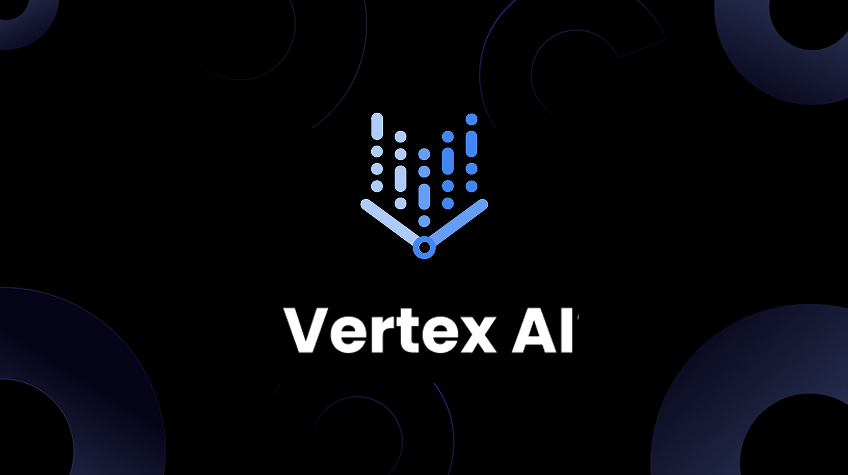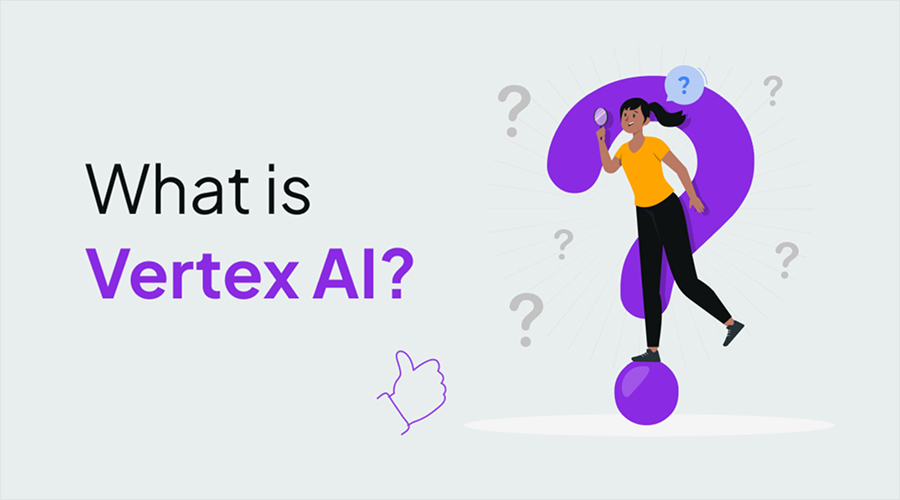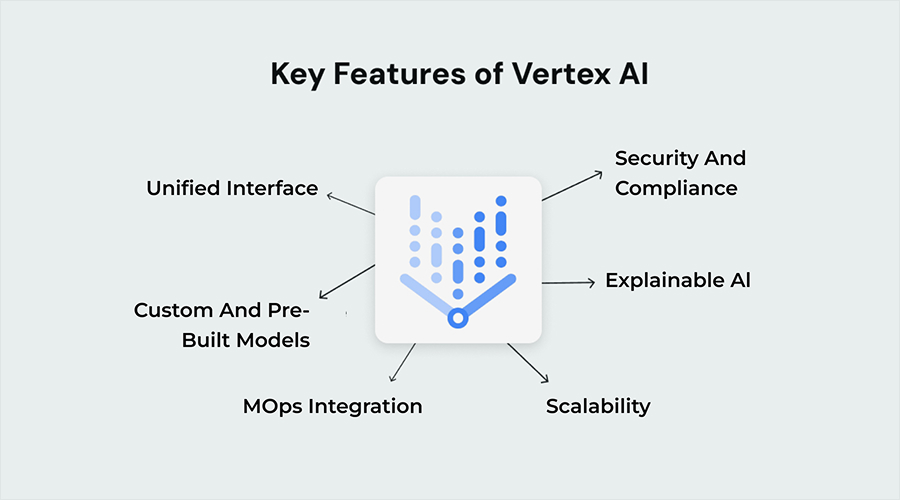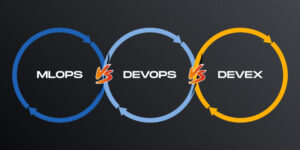
Vertex AI is a single platform developed by Google Cloud that can be utilized in building, training, and deploying machine learning models. It automates workflows of AI using AutoML, models, and MLOps. This blog explains the working process of Vertex AI, its main features, advantages, and the reason why it changes the process of AI utilization in businesses.
Nowadays, AI is transforming the rules of the game in all types of industries, including hospitals, banks, stores, and factories. However, the process of constructing and implementing AI models may be complicated, particularly when faced by companies with low data science capacities. This is where Vertex AI, Google Cloud’s unified machine learning (ML) platform, comes in. It simplifies the whole ML cycle and allows accessing all tools that a data scientist may need in a single location, including data preparation, model training, deployment, and monitoring.
Experienced innovators as well as beginners using machine learning can now integrate AI into their company with Vertex AI, which accelerates the process. It also allows you to work with no-code tools such as AutoML and build your model, so your team can get an idea and turn it into a working product in record time.
What Is Vertex AI?

Google Cloud Platform (GCP) Vertex AI is a managed machine learning platform that may be used by both developers and data scientists to build, train, deploy, and manage ML models in a single collaborative environment. It is compatible with AutoML (the no-code or low-code machine learning tool developed by Google) and enables creating models with common frameworks, like TensorFlow, PyTorch, or scikit-learn.
Before the introduction of Vertex AI, Google Cloud Platform offered a variety of independent tools to cover different phases of the ML lifecycle. Vertex AI unifies all these tools into a single system, making workflows more seamless, faster, and collaborative. As the demand for smarter and more efficient ML solutions continues to grow, platforms like Vertex AI are at the forefront of evolving ML Trends that shape the future of artificial intelligence.
Key Components of Vertex AI
- AutoML: AutoML enables a user to create good models without coding. You input your data and AutoML does the preprocessing, training the model and tuning, and deployment.
- Vertex AI Workbench: It is a Jupyter notebook integrated environment. It allows exploratory data analysis, feature engineering, and model training, with access to Vertex AI tools.
- Vertex AI Pipelines: A platform to construct and control ML workflows as recurrent pipelines. It is an extension of Kubeflow Pipelines, with support for CI/CD of ML.
- Model Registry: It is a centralized store, and in it, all of the trained models can be versioned, organized, and tracked. It makes cooperation and model management easy.
- Feature Store: A fully supported storage, sharing, and re-use of an ML features repository. It brings consistency in training models and making forecasts.
- Prediction Services: It means with these services, you can serve your models in batch or real-time with a couple of clicks.
How Does Vertex AI Work?

Step 1: Data Preparation:
You begin by loading your data into Google Cloud Storage or BigQuery. Vertex AI allows you to clean, explore, and prepare the data with tools such as Workbench or Dataflow. This is the process of making sure that your data is formatted and of a quality that should be in a state of training to create a correct and working machine learning model.
Step 2: Model Training
Next, you use AutoML or your code to train your model. AutoML is perfect for a beginner and does everything automatically. If you are experienced, you will be able to write your code with frameworks, such as Tensorflow or PyTorch. The usage of Vertex AI scales the computing resources according to your needs, which simplifies training and streamlines it.
Step 3: Model Evaluation
Once trained, Vertex AI tests your model and checks its performance efficiency. It displays useful metrics such as accuracy, precision, and recall to enable you to know the strengths and weaknesses of the model. The results can be seen in an easy dashboard, and they can be improved where necessary before proceeding to the next stage of
implementation.
Step 4: Deployment
When you have prepared your model, you can easily deploy it with the help of Vertex AI. The platform installs an endpoint to take prediction demands in batched form or in real-time. Google Cloud takes care of all the infrastructure, and you do not need to scale or configure a server; it is fast, dependable, and made to be performative.
Step 5: Prediction and Monitoring
Once deployed, your model will be able to start making forecasts. The model should be monitored over time, and Vertex AI provides such tools. It can pick up problems such as a fall in the accuracy or alterations in the data. This will assist in keeping your model updated, and you may retrain it to follow the changes in the real world when necessary.
Key Features of Vertex AI
- Unified Interface: The end-to-end management of projects is simplified in the sense that the Vertex AI integrates training, deployment, and monitoring on a single console.
- Custom and Pre-built Models: There are pre-trained models, or get your data-driven models across popular open-source libraries.
- MLOps Integration: It enables modern MLOps practices and is compatible with Vertex AI Pipelines, CI/CD tools, and Model Monitoring.
- Scalability: It also uses the infrastructure of Google Cloud to automatically scale training jobs or prediction endpoints depending on activity.
- Explainable AI: Vertex AI also has Explainable AI tools, which are used to educate developers and stakeholders on the prediction process of the model.
- Security and Compliance: It has in-built encryption, identity management (IAM), and audit logging, besides supporting GDPR and HIPAA compliance, making it well-suited for secure and scalable cloud services environments.
Advantages of Vertex AI
- Faster Time to Market: Vertex AI reduces development time with AutoML and pipelines that are ready to use. It takes days rather than weeks to develop and run a model.
- Cost Efficiency: Vertex AI provides cost optimization by allowing you to deploy serverless or managed compute options.
- No-Code to Pro-Code Flexibility: An application at any level of skill, Vertex AI, which has an AutoML feature that assists business analysts and ML engineers.
- Enterprise-Ready: Constructed on Google Cloud, Vertex AI has enterprise-level security, reliability, and compatibility with other services such as BigQuery, Dataflow, and Looker.
- End-to-End MLOps Support: Automate the whole lifecycle- training, deployment, monitoring, and retraining, with integrated MLOps tools.
- Reduced Operational Overhead: No more worrying about provisioning GPUs or dealing with Kubernetes clusters. With Vertex AI, infrastructure management is abstracted to allow you to work on ML logic.
How Vertex AI Compares to Other ML Platforms
| Feature | Vertex AI | AWS SageMaker | Azure ML Studio |
|---|---|---|---|
| AutoML Support | Yes | Yes | Yes |
| MLOps Tools | MLOps Tools Integrated | Requires setup | Partially integrated |
| Notebook Environment | Jupyter (Built-in) | Jupyter (Optional) | Jupyter (Built-in) |
| Feature Store | Yes | Yes | Yes |
| Pricing Flexibility | Pay-as-you-go | Pay-as-you-go | Pay-as-you-go |
| Cloud Native | GCP | AWS | Azure |
Use Cases of Vertex AI
The Vertex AI is applicable in numerous sectors and resolves real-life issues through the strength of machine learning.
- Businesses in retail implement it to provide product suggestions, depending on the customer behaviour, resulting in more sales and personalization.
- In the medical field, it assists medical doctors who analyze medical images to make quick, accurate diagnoses.
- Fraud detection enables financial institutions to identify strange transaction habits with the help of Vertex AI.
- In the manufacturing industry, it is useful in predictive maintenance and analysis of machine data as a method of avoiding breakdowns.
- It is used to create clever chatbots that respond and understand questions in a natural language by Customer service teams.
Vertex AI allows any organization to make AI practically useful and impactful in terms of scaling and utilizing it through its flexibility, ease, and simplicity of use.
Conclusion
In conclusion, Vertex AI is an ideal option if you want a high-performance, versatile, and ergonomic platform to scale your machine learning endeavors. It combines all we need, including data preparation, deployment, and integration under a single roof.
Explore AI with small development teams or scale production ML systems to the full range. Vertex AI has everything you need to start or test a project, prepare for repeated training of the same model, develop and run production ML systems and applications. By accessing Google infrastructure, in-built automation, and teamwork tools, Google enables teams to innovate quickly and smartly.






